Star Fighter: Lockheed F-104 Starfighter Fighter
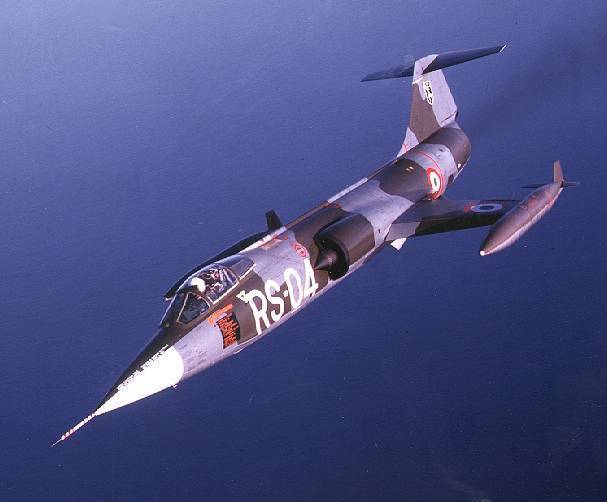
The birth of "Star Fighter"
The idea of creating a two-winged fighter was proposed by Clarence “Kelly” Johnson, the head of the Lockheed’s secret development department, at the beginning of 1950. However, at that time, the future Skunk Works department - this name will appear in ten years - was occupied by other projects and a new fighter was started to be created only after a year and a half. The fact is that at first the idea of Johnson seemed to the leadership and the military too bold. But by the middle of the Korean War, it became clear that the existing technology no longer warped and fighter aircraft simply must change their appearance. At the same time, the Johnson team was not forbidden to conduct research on the prospects of fighters. Later it had a positive effect on the timing of the concept.
The pursuit of speed determined a number of basic design features of the L-246 aircraft (this was the designation of the project in the design bureau). To achieve speed in M = 2, the designers of Lockheed simultaneously began to implement two ideas. The first concerned the installation of the engine with the maximum possible power, and the second meant the provision of minimal airframe resistance. Since the creation of the engine for the two-wing L-246 was not the responsibility of the Kelly Johnson design team, for the time being we will only focus on the aerodynamic and weight side of the project. As in the early years of aviation, the design of the L-246 was made as easy as possible, naturally, without loss of strength. Similarly, they tried to make the outer contours of the aircraft. So, on the surface of the fuselage and wings, the designers tried to leave only the minimum necessary number of technical hatches, etc. Larger units, such as the fuselage, wing or tail, were made in the form of a kind of compromise between minimal resistance and effective work. Therefore, the wing of the new fighter in the end turned out to be unusually small. Subsequently, this will lead to the nickname "The missile with a man in it" ("Rocket with the man inside").
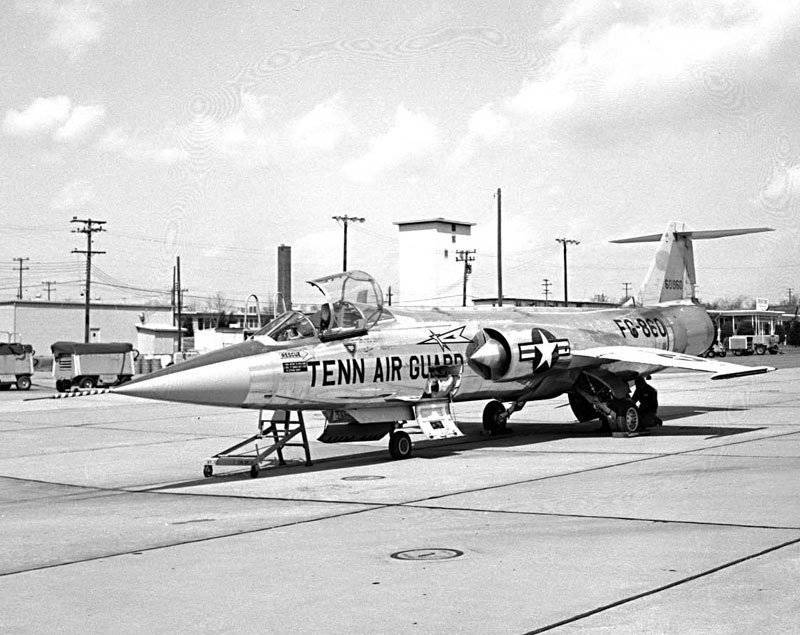
It should be noted that this approach to the aerodynamics of the aircraft did not become exclusively positive. Yes, the high-speed potential of the fighter was much higher than that of the “traditional” aircraft of the time. But the high maximum speed had a bad effect on maneuverability. True, the customer represented by the US Air Force was not against it. It was assumed that L-246 will become an interceptor in the classic sense of the term. He will take off, quickly go to the interception area, quickly attack the target and return to the base. Maneuverable air combat in this concept was included solely as a small and far from the main addition. So the military did not resent the specific characteristics of the aircraft being built.
The relatively poor maneuverability of the L-246 had several reasons. The main one concerned the wing. Several experimental aircraft of the X series and a series of tests at NACA to the beginning of the creation of a new fighter allowed to find out the features of the flight at a speed twice the speed of sound. Among other things, at such speeds, the swept wing lost its effectiveness. Triangular or trapezoidal planes looked more comfortable and promising. High speeds also required an even thinner wing than before. As a result, the Lockheed constructors stopped on a trapezoidal wing with an elongation around 2,45 and the thinnest profile for that time — the entire 3,4%. The small thickness of the wing led to the fact that the radius of curvature of the wing nose did not exceed 0,5 of a millimeter. All this required new materials and new technologies that could ensure the required accuracy of parts manufacturing. Subsequently, the front-line technicians even had to cover the wings of the F-104 aircraft with specially made canvas covers with soft inserts. Without them, you could easily damage the edge of the wing and even get injured. However, a thin wing of small elongation is effective only at high speeds. To ensure the normal take-off and landing characteristics, Johnson and his associates had to equip the wing with deflecting socks along the entire length and large-area slit flaps.
Saving fuselage volume required engineers to equip F-104 with T-shaped tail. There were simply no other ways to give the plane a full-circle stabilizer. It is worth noting the fact that the effectiveness of the stabilizer, which served as the elevator, was sufficient to parry the moment for a dive, which occurs in the transonic speed range. At the same time, the tendency to dive was to some extent compensated for by high thrust-to-weight ratio - the aircraft could quickly “slip” through a dangerous range of speeds and then fly more stably. Rudder placed in the rear of the keel. In size, he did not represent anything remarkable.
The General Electric J104-GE-79 engine was chosen as the power plant for the future F-3. This forced turbojet engine was created simultaneously with the aircraft. The estimated thrust of the turbojet engine exceeded 4500 kgf, which, in combination with the estimated take-off mass of the fighter, of the order of ten tons, gave a fairly good thrust-to-weight ratio. Development of the engine was quite difficult, which is why during the tests of the aircraft several problems arose, but about them a little later.
The armament of the L-246 project consisted of one six-barrel automatic gun M61 Vulcan and two knots for the suspension of guided missiles. The implication was that two missiles would be enough to intercept enemy aircraft. By modern standards, this is not enough, but at the beginning of the 50-s it was considered that two missiles and a two-stroke speed are quite acceptable for a promising interceptor. In the end, the gun "Volcano" had a huge for that time rate of four thousand rounds per minute. In the light of the lack of decent air-to-air missiles, the combination of only two guided munitions and a rapid-fire cannon looked like the best solution with a backlog for several years ahead.
Finally, in accordance with the latest requirements for the safety of aircraft, the Johnson team provided an ejection seat for the L-246. Since the appearance of the means of salvation in 50's has not yet been worked out, the ejection of the seat with the pilot did not occur upwards, as is customary now, but downwards. This method of pilot rescue was chosen for several reasons. First, the ejection down was simpler technically; secondly, because of the impossibility of the chair colliding with the tail, it was possible to reduce the ejection velocity, and thirdly, the pilot almost did not risk a spinal cord injury. Only all three pluses were compensated by rather serious minuses. So, when the pilot was shot down, the pilot experienced a considerable negative overload, which in itself is far from good for health and well-being. In addition, before opening the parachute, the seat with the pilot lost at least 400-450 meters of altitude. Thus, on takeoff or landing, a serious accident put the pilot in front of a difficult choice: to eject and be “shot” to the ground or to fall along with the plane. And well, if there was an opportunity to plan and firmly sit on the belly ...
Combat pilots would hardly have approved such a feature of the rescue system. But the US military leadership, seeing the results of air battles over Korea, paid more attention to the flight characteristics and tactical advantages of the new aircraft, rather than the ejection of the pilot. In the autumn of 52, the L-246 project was approved by the Air Force Commission and 12 in March 1953 requested Lockheed to build two prototypes of the XF-104 fighter. Together with the army designation of a new aircraft and got its own name - Starfighter ("Star Fighter"). F-104 now took less than a year to assemble the first two copies. At the same time, even before the tests began, the Pentagon, apparently evaluating the prospects of the fighter, made an order for another 17 pre-production YF-104 aircraft and six production F-104 versions "A". Overall, gentlemen from the Pentagon were very optimistic about the project. For example, it was planned that the first "Starfighters" would go to the troops already in 59. At Lockheed, this optimism was not shared. The problems began at the assembly stage of the prototypes. When the first XF-104 was in a fairly high degree of readiness, it turned out that General Electric did not have time to complete the new engine by the previously agreed date. Since they didn’t want to break the deadlines, even if through someone else’s fault, they urgently had to redo the design of experienced aircraft to install Armstrong Siddeley Sapphire engines. It had slightly lower performance than the J79-GE-3, but there was almost nothing to choose from.
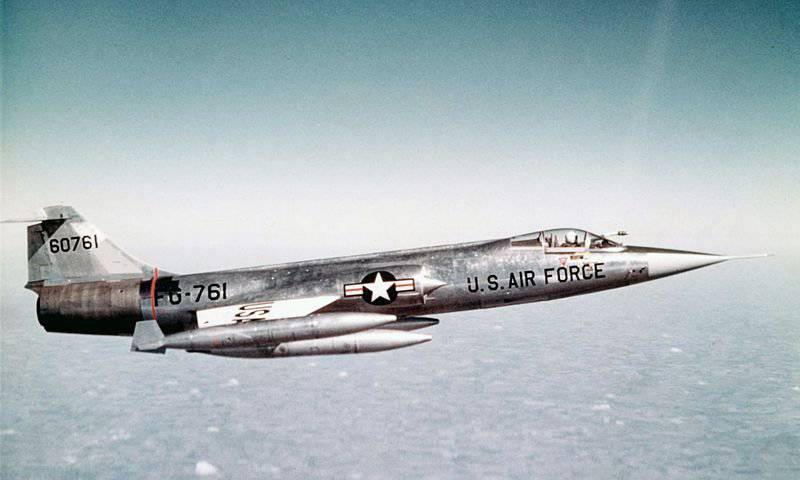
From theory to practice
In February, 1954, as it was stated, the first XF-104 was delivered to Edwards Air Base. February 27 began taxiing. In just a few days - March 4 - pilot T. Levie first pulled the handle towards himself and lifted the Starfighter into the air. The joy of the first flight was overshadowed by two problems at once. At first it was not possible to remove the chassis, and then began to interrupt the operation of the fuel pump. The plane was carefully investigated and the causes of the problems seemed to disappear. However, from time to time, problems with the chassis and pump made themselves felt during the next few flights. To complete their elimination took several months. At the same time, other design defects were eliminated. As a result, with the help of a non-native engine from Armstrong-Siddley, the XF-104 25 March aircraft 55-th climbed to an altitude of 15 kilometers and reached a speed that was 1,79 times the speed of sound.
In April, 54 began testing. weapons. The 20-mm six-barreled gun showed great promise. Until the shooting began. During the first volley it turned out that the shells were flying out of the neck of the sleeve with too much speed. After several turns, the liners punched a rather big hole in the fighter's skin. By a happy coincidence, the fuel line, which was held in this place of construction, was not injured. After this incident, the plating was strengthened in “risk zones”. The boost helped, but the prototype was still lost. During the flight to 25 on April 1954, when firing from a huge recoil, the M61 gun fell from its mountings. While pilot G. Salomon reacted and released the trigger, the gun literally smashed the nose of the aircraft. There was no hope of saving the car and the pilot ejected. This is how the sad loss list began, which F-104 will then blame.
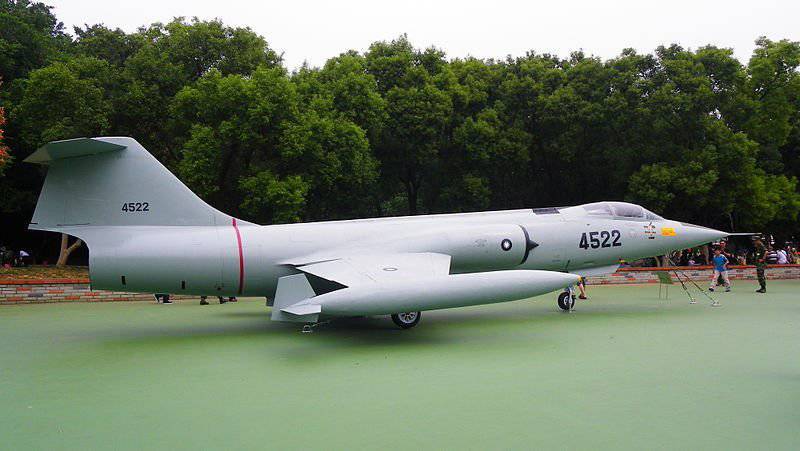
After the loss of the prototype, the tests were suspended for almost ten months. During this period, the YF-104 has now received the “native” engine J79-GE-3, as well as adjustable air-intake cones. On the XF-104, they were stationary and, as it turned out, unable to ensure stable engine operation in all flight modes. Moving cones had a specific configuration and the original movement mechanism. Because of this, during the ceremonial roll-out of the first fighter YF-104 (16 February 56-th), the inlet devices of the air intakes were closed with special metal covers. Also, the YF-104 had a longer fuselage. The fact is that for the installation of TRD "Sapphire" had to significantly revise the design of the aircraft. This engine had a smaller size - to install GE J79-GE-3 had to "increase" the fuselage by almost two meters. In addition to a number of other external changes (new service hatches, etc.), the exterior of the aircraft changed due to the placement of wing pylons for guided missiles or outboard fuel tanks at the wing tips.
The YF-104 tests fully confirmed the correctness of the engine selection, although the interceptor specifications were still insufficient. First of all, the questions were caused by an excessively large take-off and landing distance. Here the recently appeared system of blowing the boundary layer from the flaps came in handy. Air was drawn from the engine compressor and redirected to the flaps. The efficiency of their work has increased significantly: the landing speed decreased by 20% to 260-270 km / h, and the landing distance was reduced by a quarter. During the tests, we had to spend a lot of time and effort on fine-tuning not only the aircraft. The engine from General Electric was still quite raw.
The Lockheed plant assembled a pre-production batch of YF-104 aircraft, and the Pentagon has already placed an order for 155 fighter jets, 18 reconnaissance aircraft and 26 training aircraft based on the F-104 project. However, the latest versions were still in the early stages of development. Such a “fat” contract was signed in December of 55, two months before the first flight of YF-104. It should be noted that this was not the best idea, and the military quickly realized this. After the start of testing the on-board electronics of the new aircraft, many engineers and the military no longer hide their doubts about the prospects of the F-104. So, the airborne radar to the beginning of the flight did not meet the requirements of the Pentagon, and the radio range finder of the sight at high speeds began to make too big mistakes. Combined with poor maneuverability at supersonic speeds, this did not allow the enemy to attack normally with the built-in Vulcan. In addition, there were problems directly with the gun. Most recoil had a bad effect on the design of the aircraft, powder gases got into the air intake, and at speeds above M = 1,5, under certain circumstances, the aircraft could literally catch up with its own projectiles. As a result, the serial F-104A lost the built-in gun, and in its place was installed a load to maintain balance. Thus, the entire armament of the first production Starfighters consisted of only two guided missiles.
In the ranks
Until the end of 1957, the 52 built aircraft were used during tests at the Edwards base. The initial plans for the start of deliveries in 56-th year were thwarted, but even a year after this period, the fighter was still not ready. Management features, weapons and performance F-104 is not fully satisfied with the military. As a result, Starfighter has ceased to be regarded as the main interceptor for the next few years. Now it has become only a temporary measure in anticipation of the F-106 Delta Dart. At the end of winter 57-th Pentagon refused to purchase reconnaissance RF-104. The order for the F-104, in turn, was reduced to 146 machines. On the old plans for 650-700 machines are no longer remembered.
January 26 1958 can be considered the beginning of a Starfighter career. On this day, a solemn ceremony of the transfer of the first combat aircraft of the 83 th squadron of air defense. The pilots were enthusiastic about the new technique. True, optimism soon disappeared: within a couple of months, half a dozen cars were lost. F-104 was too strict even for experienced military pilots. And, as noted by those who were lucky not to crash with the plane, Starfighter did not “warn” about the wrong piloting. He immediately fell into a corkscrew. Due to accidents in the 58 Squadron from April to June of the 58 of the year, flights to the F-104 were suspended. Nevertheless, the production of new aircraft continued and they still went into parts. In other connections, the development of a new aircraft was also far from simple. Fighters regularly fought and sometimes claimed the lives of pilots. The probability of the death of the pilot and increased the catapult. Since it was too late to remake it, it was recommended to pilots when flying at low altitude to turn the plane “belly up” and to eject. Of course, it was not always possible to do this maneuver.
Army wits quickly came up with "Starfighter" new nicknames. At various bases, F-104 was called “Flying Coffin” (“Flying Coffin”), then “Leaving Widows” (“Widowmaker”). Against this background, the nickname "Pregnant Pin" ("The Pregnant Hatpin") did not look so offensive. Meanwhile, Lockheed offered new uses and equipment for the aircraft. For example, the development of an air-to-air missile with a nuclear warhead began. However, a kiloton rocket did not allow to hang it on its wings. Under the "Starfighter" fuselage, she strongly interfered on takeoff and did not allow her to land without dropping her. But several modifications of the fighter were created and mass-produced:
- F-104A. Basic version;
- F-104B. Training double fighter. With the exception of an additional cabin and some electronics, it is similar to option “A”;
- F-104C. It is a basic "Starfighter" with a new engine GE J79-GE-7, new sighting equipment and a ventral pylon for the suspension of weapons;
- F-104D. Upgraded training F-104B;
- F-104G, F-104J, F-104S - export versions of F-104A, intended for deliveries to Germany, Japan and Italy, respectively. From each other and from the original fighter differ in the composition of the onboard equipment.
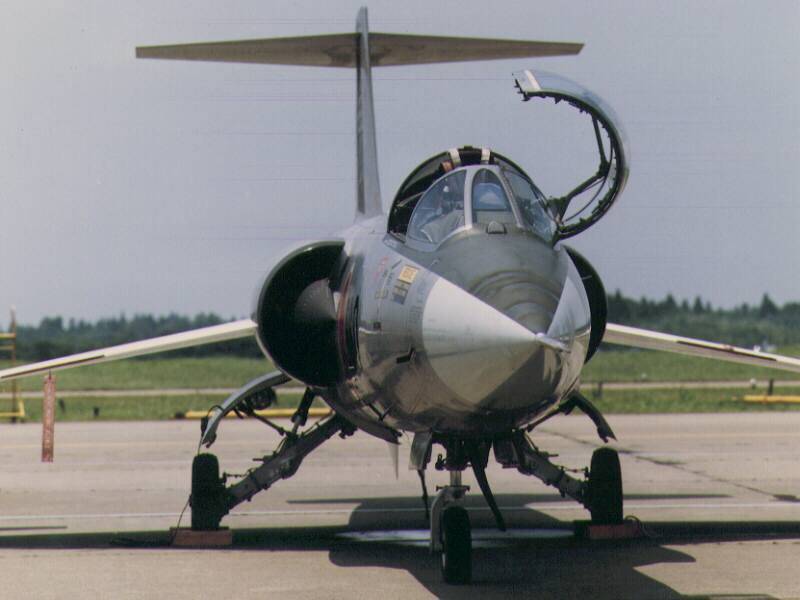
In the middle 60-s, the prospects of Starfighter were quite clear. Therefore, on 22 serial aircraft, some parts of the avionics were dismantled, and instead of them, cameras and remote control equipment were installed. Under the index QF-104, these aircraft were used to test anti-aircraft missiles as radio-controlled targets.
Despite the fact that the F-104 served up to the Vietnam War, they did not have much success in battle. In 1965, the 476 wing was sent to South Vietnam. According to reports, there were F-104C with the ability to attack ground targets. Details of the application have never been published, from which it is often concluded that there is no success. A couple of months, the American pilots worked in Vietnam, after which they were transferred to Taiwan to work in the island’s air defense. September 20 one of the F-104 accidentally (according to the official American version) entered the airspace of China, where he was shot down by the Chinese MiG-19. American pilot died.
While the 476 wing was operating in Taiwan, the F-104A and F-104B modifications began to be removed from service. Their work is now trusted options "C" and "D", respectively. It was on these planes that part of the 476 of the wing was flying, which in 66 was again sent to Vietnam. Aircraft based in Thailand participated in the raids during the year. It is noteworthy that only the number of departures and the total plaque is known. About the effectiveness of these flights or data loss is not. Low benefit is indirectly confirmed by the fact that after returning to 67-m home in the States, all Starfighter squadrons were sent to storage. In 1975, they were written off and disposed of.
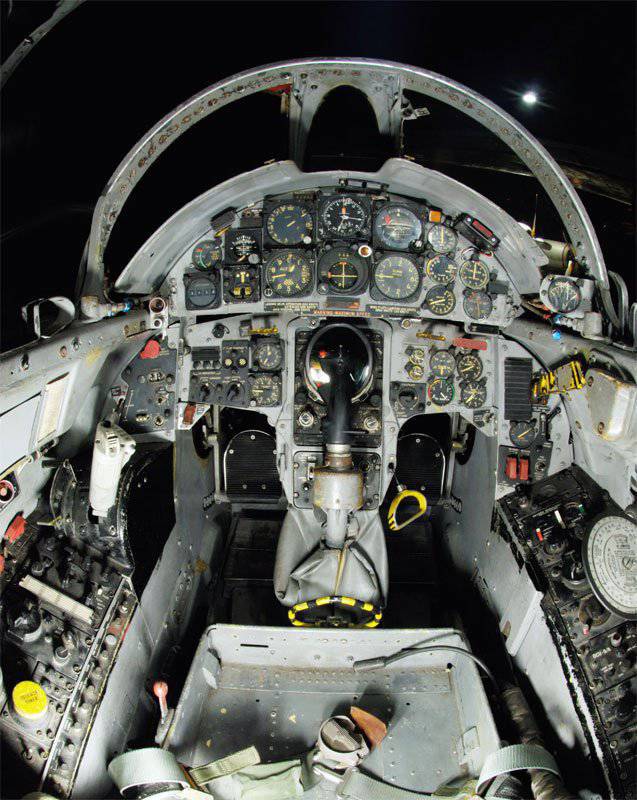
The 476 aircraft wing was the last F-104 in the United States. In just a few years of operation, out of nearly three hundred serial F-104, a quarter was lost. Two dozen pilots died. In 1966, mass production for its own needs was discontinued.
Abroad
Shortly after the start of full-fledged serial production of the F-104A aircraft, Canada became interested in the new fighter. At the request of the official Ottawa on Lockheed, work began on reworking the aircraft for Canadian needs. September 19 61-th for the first time took off an experienced copy of the CF-104. According to its capabilities, it was a cross between F-104A and F-104C. The CF-104 did not have a cannon (a fuel tank was installed in its place), another radar and avionics specialized for ground targets. The initial contract of Canada and Lockheed implied the construction of experimental machines and a series of 38 fighters. Further production was deployed in Canada. For their own needs, this country assembled 200 fighters and another 140 was sold to third countries.
A similar situation exists with the export F-104G, with the difference that it was ordered by the Federal Republic of Germany. From 1962, the first F-104Gs assembled in Germany began to arrive in German units. In a year and a half, the 12 regiments of the German Air Force were transplanted to the new technology. The differences between the F-104G and the original Starfighter were almost the same as those of the CF-104. Based on the F-104G, with virtually no changes in the design and equipment, a modification of the F-104J for Japan was created. Like other countries, Japan received several aircraft from the United States, and the rest made their own.
In addition to the sale of special modifications for friendly countries, the United States traded used aircraft. For example, in 65, Pakistan received a couple of dozen used F-104A. In the same year, Pakistan attempted to use the received aircraft in battles with India. Much success, however, the Pakistani pilots have not achieved. For each shot down Indian plane accounted for shot down "Starfighter".
Serving outside the United States, F-104 of various modifications retained its high accident rate. So, from the 900 with more than one machine available to the FRG, almost three hundred were lost. Crashed 116 pilots. At one time in Germany there was a major scandal over the advisability of using such a dangerous fighter. The active and consistent opponent of the Starfighters was the famous German pilot E. Hartmann. However, the large number and economic side of the replacement did not allow all F-104s to be removed from service at once and to put something more secure in their place. Much less lucky Canadian pilots. At the time of the removal of fighters from the missile miss 45% of machines. It was the service in Canada that became a “record” for the F-104. At the same time, it should be noted that none of the Spanish X-NUMX F-20G (for 104-7 years all 8 had flown thousands of hours together) was not lost.
The Lockheed F-104 Starfighter fighter was a breakthrough for its time. He was the first in the world to achieve two speeds of sound, he had a wing unique for his time, etc. But the high demands on the aircraft eventually led to serious problems. Interestingly, this was the case with most Lockheed airplanes developed in the Clarence Johnson section. The group of designers, now called Skunk Works, has always been able to do the impossible. Only almost all of this was done at a high enough price. So, the U-2 scout with excellent heights and distances was extremely uncomfortable during takeoff and landing. The SR-71 flew three times faster than sound, but operation was extremely expensive and difficult. Finally, the F-104 met the flight requirements of the original terms of reference, but it was very difficult and dangerous to fly it.
The moral of this stories is simple. Evaluation of technology for maximum performance is fundamentally wrong method. Evaluation of the characteristics and the parameter "cost-effectiveness" is also not always useful. The fact is that at the design stage, the F-104 was able to bypass several competing aircraft in terms of price indicators. The US military and designers in pursuit of speed have forgotten about usability. Taken together, this was the reason that the F-104 remained in the history of world aviation not only Starfighter, but also Leaving a Widow.
On the materials of the sites:
http://airwar.ru/
http://nf104.com/
http://brazd.ru/
http://aero-web.org/
http://b737.org.uk/
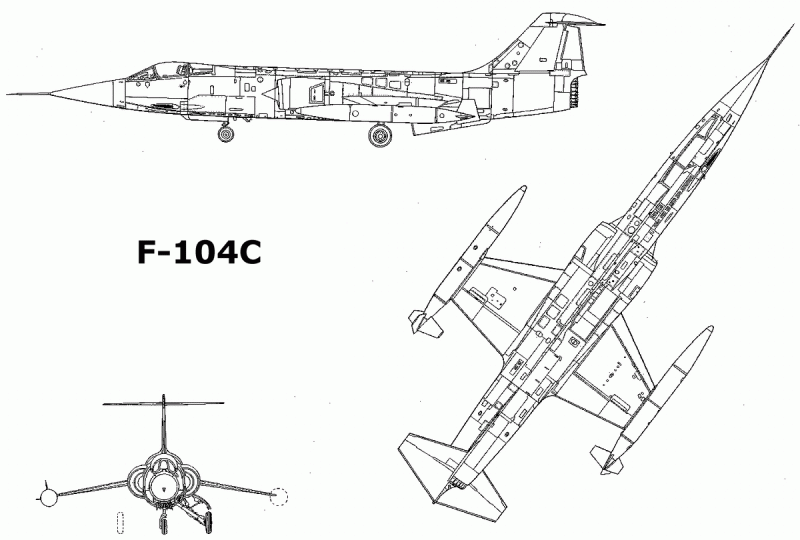
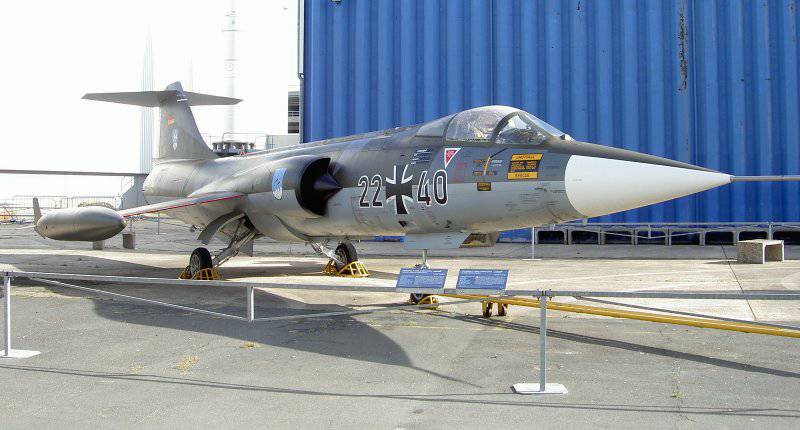
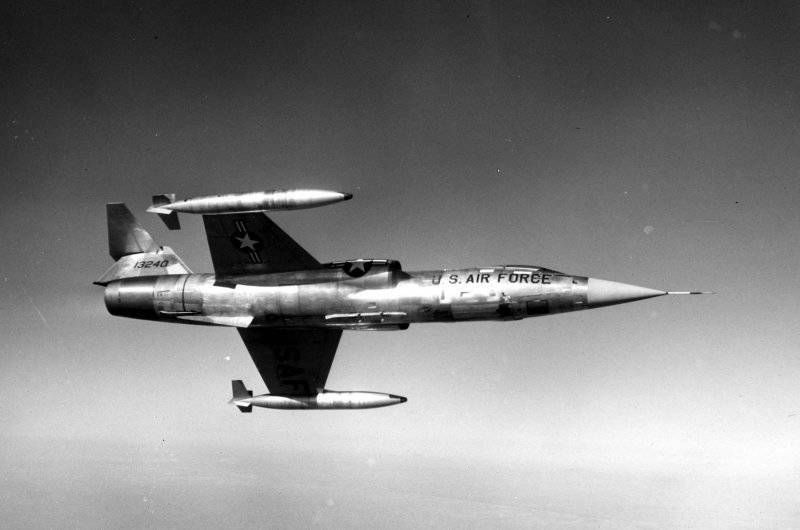
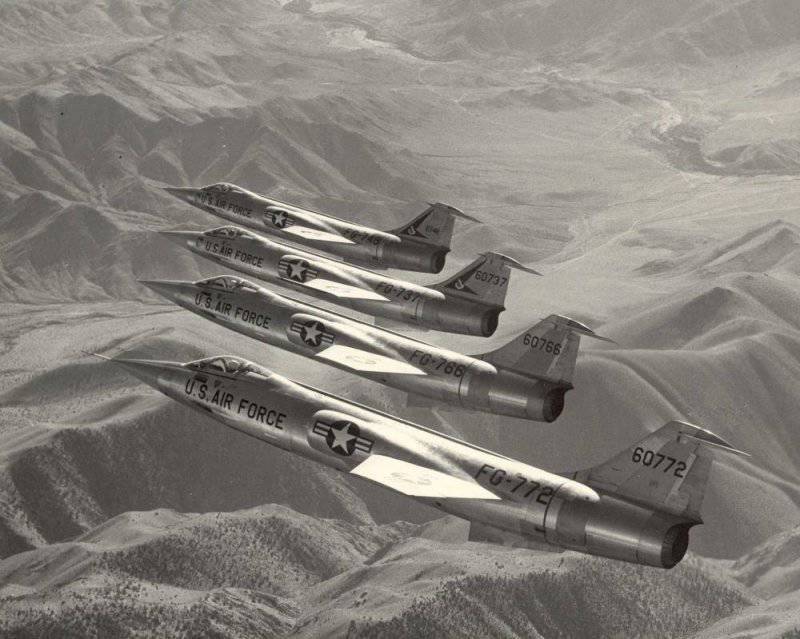
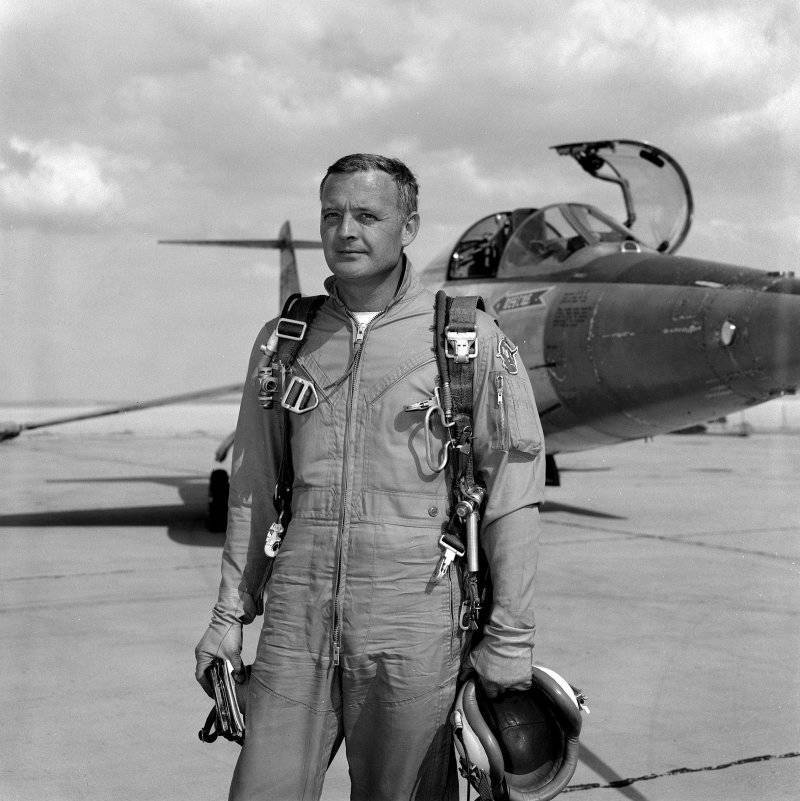
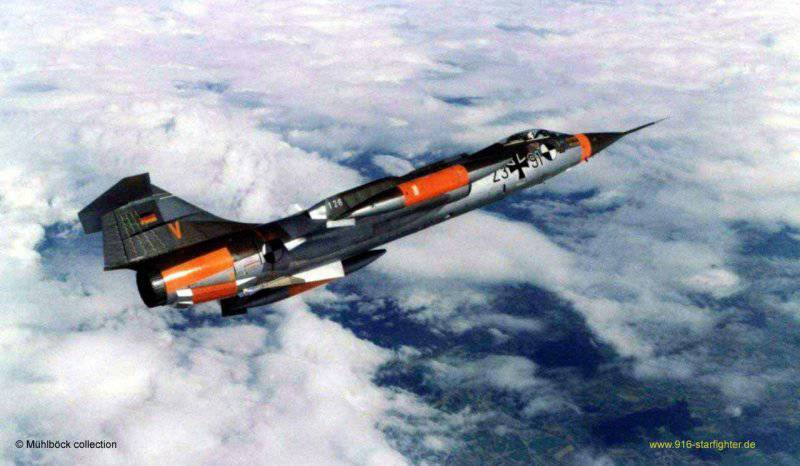
Information